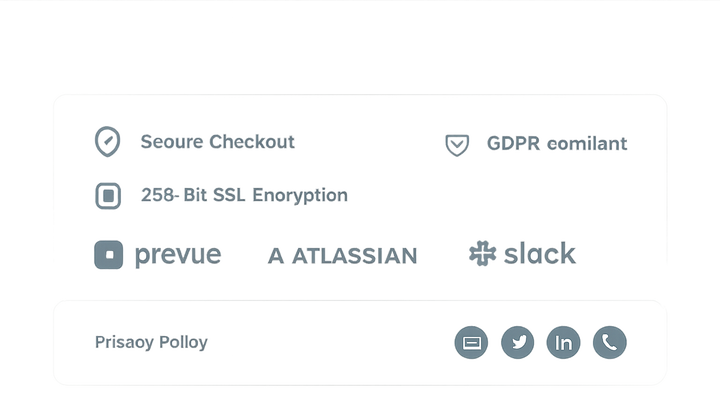Published on 2025-06-29T21:09:28Z
What is a SaaS Trust Footer? Examples and Best Practices
A SaaS Trust Footer is a specialized website footer section that consolidates credibility signals and essential links to bolster user confidence in a software-as-a-service offering. It typically features security badges (like SSL and SOC 2), compliance certifications (e.g., GDPR, CCPA), client logos, privacy and terms links, and contact or support details. By presenting these trust elements uniformly across all site pages, a trust footer reduces friction at critical decision points and encourages conversions. From a UX standpoint, a clear and accessible footer improves navigation, making it easy for users to find legal, support, and policy information. SEO benefits arise when trust footers include structured data and well-organized links, signaling authority to search engines and improving discoverability. In this article, we delve into the importance, components, design best practices, and real-world examples of SaaS Trust Footers, including how Prevue.me leverages trust footers to maximize lead generation and CRO.
Saas trust footer
A SaaS Trust Footer centralizes trust signals, legal links, and contact info to boost credibility, CRO, UX, and SEO.
Why a SaaS Trust Footer Matters
A trust footer consolidates credibility elements at the bottom of your site, ensuring they are visible across all pages. It reduces buyer hesitation by highlighting security, compliance, and social proof without intrusive pop-ups. From a UX perspective, a well-designed footer aids navigation and provides users with quick access to essential links. For SEO, footers enriched with structured data markup signal trustworthiness to search engines, potentially improving rankings. Most importantly, a trust footer can directly influence conversion rates by reinforcing confidence at the decision-making point.
-
Building credibility
Security badges, compliance certificates, and client logos in the footer reassure visitors that their data and investments are protected.
- Security certifications:
Display SSL seals, SOC 2, and ISO certifications to prove robust data security measures.
- Client logos:
Showcase recognizable brand logos to leverage social proof and authority.
- Security certifications:
-
Enhancing user experience
A structured footer provides users with intuitive navigation to legal, support, and resource pages without cluttering the main content area.
- Clear navigation:
Group links logically under headings like Resources, Company, and Support.
- Accessibility options:
Include language selectors and accessibility statements to cater to diverse audiences.
- Clear navigation:
-
Boosting seo
Footer links and schema markup help distribute link equity and signal trustworthiness to search engines, aiding in discoverability.
- Structured data:
Implement schema.org Organization and WebSite markup for improved search visibility.
- Semantic linking:
Use keyword-rich anchor text for footer links to relevant pages.
- Structured data:
Key Components of a SaaS Trust Footer
To maximize impact, a SaaS Trust Footer should include a mix of security indicators, social proof, essential company information, and navigational links. These components work in concert to deliver both functional and psychological reassurance to users, ensuring clarity and minimizing friction.
-
Security badges
SSL seals, encryption icons, and compliance certifications (e.g., GDPR, CCPA) inform users that data transfers are secure.
-
Client logos & testimonials
Logos of well-known customers and short user quotes can serve as powerful social proof.
-
Legal & policy links
Transparent links to Privacy Policy, Terms of Service, and Cookie Policy demonstrate compliance and reduce legal uncertainty.
-
Contact & support
Direct links to support channels, email addresses, and live chat options make it easy for users to get help.
-
Accessibility & language options
Language switches and accessibility statements signal inclusivity and compliance with accessibility standards.
Design Best Practices
Designing an effective SaaS Trust Footer requires attention to visual hierarchy, responsiveness, and performance. A cluttered or slow-loading footer can negate its benefits, so it’s essential to balance comprehensive information with clean design and efficient code.
-
Visual hierarchy
Use typography, spacing, and color to prioritize critical trust elements and guide the eye toward call-to-action links.
-
Mobile responsiveness
Ensure the footer adapts to various screen sizes, keeping touch targets accessible and legible on mobile devices.
-
Readability & contrast
Maintain high contrast between text and background, and choose legible fonts to improve accessibility.
-
Code efficiency
Optimize images and avoid bulky scripts to ensure the footer doesn’t slow down page load times.
-
Consistency with brand
Align footer design with overall brand style, using consistent color palettes and iconography.
Impact on CRO, UX, and SEO
When implemented correctly, a SaaS Trust Footer can deliver measurable improvements in user trust, site engagement, and search performance. Monitoring these metrics helps refine the footer over time.
-
Conversion rate optimization
By reinforcing trust at the bottom of the page, trust footers can reduce cart abandonment and increase form submissions.
-
User experience
Easy access to support and policy information decreases frustration and enhances satisfaction, measured by lower bounce rates and higher time-on-page.
-
Search engine optimization
Structured data in the footer can generate rich snippets and strengthen site authority, boosting organic traffic.
Examples of SaaS Trust Footers
Let’s examine how leading SaaS companies like prevue.me implement trust footers to drive lead generation, conversion, and SEO. These real-world examples illustrate best practices in action.
-
Prevue.me
prevue.me’s footer showcases badges for Actionable CRO Critiques, SEO-Optimized Reports, and WCAG Accessibility Checks, along with client logos and direct contact links, reinforcing credibility for potential clients.
-
Slack
Slack uses a minimalist footer with links to Security, Privacy, Terms, and Compliance pages, complemented by a Trust Center badge.
-
Shopify
Shopify’s footer includes payment icons, Shopify Trust badge, privacy and cookie policy links, and a global language selector, catering to an international audience.
